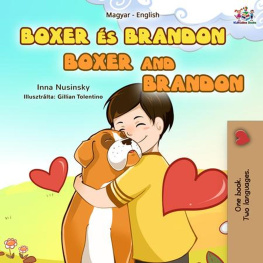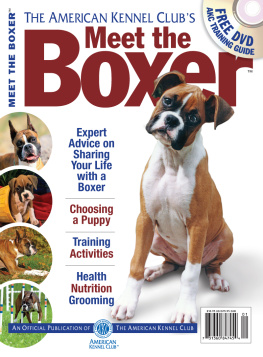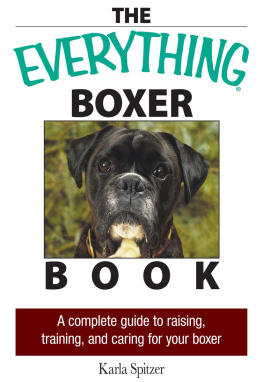A New Owner's Guide to Boxers
Introduction
Possibly one of the most famous of dog breeds, the Boxer is a descendant of the Bulldog, and is native to Germany. Because it is a descendant of an ancient fighting breed, the Boxer has often been kept as a guard-dog, as well as being used by police and military throughout the world. The Boxers athleticism and intelligence meant that for many years these dogs were also trained as hunting dogs.
The Boxer owes its name to the fighting stance the dog takes when battling with its opponents. It stands on its hind legs and appears to box its opponents with its front paws in a stance similar to that of a boxer.
Today, Boxers are popular not for their fighting qualities, but rather their calm and loyal nature. Boxers are intelligent, fun-loving, and great with children, making this breed the ideal family dog. It has also been used as a "seeing-eye" dog due to those same characteristics.

Image via Peter Hellberg .
The Boxer's Physical Characteristics
With its high head, protruding jaw, extremely expressive face and proud carriage, the Boxer is instantly recognizable. The expressive nature of its face is further highlighted by its mood-mirroring dark brown eyes and the distinctive wrinkling of its forehead.
It is a strong, solidly built dog that will reach an adult weight of between 65 to 70 pounds when in good condition. Good condition for this dog breed means lean and muscular, as any fit athlete should be. It will reach a height of approximately twenty-four inches in adulthood.
The Boxer's coat is short, shiny and tight to the body. Its coat color is fawn and brindle, and occasionally white. There are often wide variations in the coloring of the brindle. The American Kennel Club provides a comprehensive guide to the Boxer's physical attributes.
The Boxer's Personality Traits
The Boxer shares many physical and temperament characteristics with other dogs, but one trait that makes it unique is its unswerving loyalty to, and affection for, its family. It is not unusual for a Boxer to be reluctant to settle down for the night until everyone is back home and safe.
Boxers behavior around children is another aspect of their character that makes this breed very distinct from many other breeds. The Boxer has a very high patience level with small children even extreme provocation. This level of patience when combined with a very loving and docile nature makes it an ideal dog for the family home.
This dog breed has justifiably earned an excellent reputation as a companion dog. Boxers enjoy human company and are extremely loyal. When meeting strangers the Boxer will remain wary and await the response of its family. The response of the family to the stranger will determine the response of the Boxer.
Are You a Suitable Owner for a Boxer?
The Boxer revels in human company and does not appreciate being left alone for extended periods of time. Boxers do not constantly crave attention, but they love showing and receiving affection. Boxers are active and athletic dogs, so they need and appreciate physical exercise. Preferably this activity would occur with its family. If at any stage there is a possibility that the dog might need to be left alone for an extended period of time you could consider using a pet sitter . The Boxer prefers a lot of space and has a large appetite, so potential owners should be aware of the associated costs.
Physical Maintenance
Caring for a Boxer is not a high maintenance job. Boxers are by nature strong, lean and muscular. They are curious and like to get out and see what is happening in the world. To this end, they need lots of movement and stimulus. In a family situation with children, those needs are easily met. In a home without children, a greater effort to provide stimuli and exercise is required.
The Boxer also has quite a large appetite so the need for exercise to maintain its lean physique is necessary. Minimal maintenance is required in caring for its coat.
How To Buy a Boxer

Image via tofslie .
Choosing a purebred Boxer ensures that you get a uniformity of size, temperament and care requirements. Knowing what your puppy will be like as an adult dog and what its requirements will be are a key part of that decision.
Only buy from registered breeders. A breeder should be able to answer all your questions, and should in turn have questions to ask you regarding the dog's future home. If they are a quality breeder they will be keen to ensure that the dog and its new family are good match. Below are some topics to discuss with the dog breeder prior to purchasing.
- How long has the breeder been in that business?
- Is the breeder a member of a state or national kennel club?
- What are the main characteristics of the dog?
- What will be the eventual size of the dog?
- What will be the exercise requirements of the dog?
- What are its nutrition needs?
- What are its maintenance needs?
- How does it behave in the company of children?
- How does it react to strangers?
- How does it react to other pets?
- Are there any specific veterinary requirements?
The American Kennel Club provides a very useful guide on buying your new dog from a breeder.
A New Member of the Family
Once you bring your new Boxer home, take some time to help it get acquainted with your family and your house. Behavior that would be acceptable in one particular home may not be acceptable in another. It is very important that a dog is aware of the boundaries and rules that limit its behavior.
Housetraining
When it comes to h ousetraining, consistency is extremely important. A dog must know that the rules will be consistently applied. This rule applies to puppies and adult dogs.
Toilet training is usually the first issue that needs to be addressed. There are three vital parts to this process if it is to work: patience, reward and consistency. Puppies have a limited capacity for self-control, and accidents will invariably happen. Place newspaper on the floor away from the dog's eating and sleeping areas. At the beginning of training it will be necessary to place the pup on the paper when it appears as if it needs to relieve itself. Sniffing, whining and turning in circles are signals that its time to move the dog to the paper.
Develop a routine of placing the pup on the paper after it has eaten or had a drink.The pup will quickly adapt to the routine. Eventually it can be let outside after eating.
Inappropriate Behavior
Inappropriate behavior such as climbing on furniture, jumping up on people, and scratching floors etc. should be immediately checked. Once the rules are applied consistently, the dog will respond appropriately. When the dog displays bad behavior a correction should be immediate. The correction should consist of a firm command such as a "NO, a gentle smack on the rump, a whistle, or a clicking sound.
Always reward good behavior with a treat, and bad behavior with a correction. The consistent application of these conditions make it clear to the dog what is acceptable and unacceptable. If you are thinking of employing someone to train your dog you should consider contacting The American Association of Pet Dog Trainers .
Socializing With Your Boxer










![Harry Boxer [Harry Boxer] - Profitable Day and Swing Trading: Using Price / Volume Surges and Pattern Recognition to Catch Big Moves in the Stock Market, + Website](/uploads/posts/book/124137/thumbs/harry-boxer-harry-boxer-profitable-day-and.jpg)



